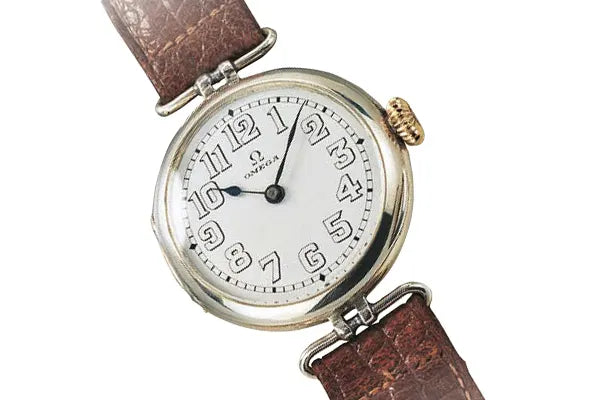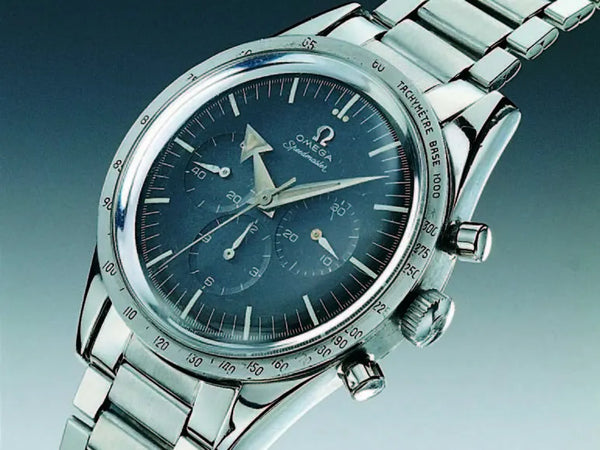
Watchmaking as a craft has evolved dramatically over the centuries. From large simple pieces to exceptionally thin complex modern devices, the forms of watches have been many throughout the years. There are always advancements, but few watchmakers are able to claim multiple innovations as part of their history. One of those brands is OMEGA.
 Photo Credit: watchtime.com
Photo Credit: watchtime.com
OMEGA's First Minute Repeater
In September 1892, the first minute-repeater wristwatch was unveiled in Bienne, Switzerland by Louis Brandt & Frére, the predecessor to today’s OMEGA watch company. Louis Brandt & Frére chose Audemars Piguet to modify a 13-ligne Lépine ébauche that Audemars had purchased LeCoultre & Cie. This unique wristwatch strongly resembled a pocket watch because of it’s case shape and size but included a wrist strap attached to two pillars at twelve and six. The large timepiece’s striking mechanism was triggered by a slide at 3 o’clock. The simple face was decorated with roman numeral hour markers and Arabic numerals placed in miniature above the minute markers.
The dust cover was engraved with a French phrase which translates to “Excluded from the competition: juror, Paris 1889”. This engraving suggests that the watch was exhibited at the Chicago World’s Fair in 1893, but was excluded from the competition in 1889. César Brandt, who ran the watchmaking firm with his brother Louis-Paul, held a seat on the jury of the Paris World’s Fair in 1889, likely excluding the timepiece from the competition for medals in Paris because of his position in the company.
 Photo Credit: monochrome-watches.com
Photo Credit: monochrome-watches.com
OMEGA's First Wristwatch
The next major milestone for OMEGA came in 1900, when the first wristwatches bearing the Omega name were produced for use by British officers in South Africa’s Boer War (1899 -1903). With the introduction of the wristwatch in 1900, the company became one of the first watchmaking firms to begin serial production of timepieces.
These first wristwatches were marketed as being tough and able to withstand the rough treatment they received from the soldiers who wore them. An advertisement in a 1904 watchmakers’ magazine recounted the testimony of a British artillery officer. His OMEGA wristwatch performed exceptionally in bitter cold, searing heat, torrential rain, and merciless sandstorms. The lieutenant colonel stated in conclusion that “The wristwatch is an essential campaign element”.
The OMEGA wristwatch had arrived as a tough, durable timepiece. Two versions were manufactured, the first with the crown on the right, to be worn on the left wrist, and the second with the crown on the left, to be worn on the right wrist. Both were powered by a Lépine 12-ligne Caliber HN B movement.
The Constellation
OMEGA began using the name “Constellation” in 1952 to refer to officially certified wrist chronometers produced by the watchmaker. The 28.1mm diameter by 5.4mm thick movement passed all official chronometer tests with flying colors. Sturdiness, reliability, and precision led the brand to begin producing the Constellation in large numbers.
The Constellation became OMEGA’s first serially manufactured chronometer wristwatch. Featuring an indirectly propelled central seconds hand, the premier model of the Constellation was powered by a Caliber 28.10 RA SC PC RG AM movement. Nicknamed the “352” the movement originally appeared in 1945 for OMEGA and wound itself via a unidirectional hammer-type winding weight. The innovation of the Constellation coupled with the clean lines of the watch face make this timepiece a true classic.
 Photo Credit: hautehorlogerie.org
Photo Credit: hautehorlogerie.org
The Speedmaster
Rarely in the realm of watchmaking can a manufacturer lay claim to the most famous timepiece in the world. OMEGA can proudly claim the most famous chronograph on the planet (and beyond) with the Speedmaster. Introduced in 1957, the OMEGA Speedmaster was adopted by NASA for use in the Apollo space program. The Speedmaster is quite possibly the best-known chronograph in the galaxy, but the origins of this famous timepiece begin well before it was launched into space.
Jacques Reymond developed a chronograph in 1943 which he called Caliber 27 CHRO C12. Reymond was born into a long-established family of watchmakers and had begun work at Lemania, a subsidiary of OMEGA, the year prior in 1942. The “CHRO” in his caliber designation stood for chronograph, with the “27” referring to the diameter in mm of the movement. “C12” represented the additional counter for 12 elapsed hours. The Reymond movement was further developed by Albert Piguet in 1946 and received the shorter designation “321”. At the time, this chronograph movement was the smallest of its type.
Lemania can also be credited for the case design of the Speedmaster, conceived by a team including designer Claude Baillod, prototype-maker Georges Hartmann, and machinist Désiré Faivre. The original Speedmaster featured a 39mm diameter case, with a 40mm version featuring a tachymeter scale on a black background first appearing in 1960. The Speedmaster featured a black dial, luminous hands, a tachymeter scale, water-resistant case, screwed back, and domed Plexiglass crystal.
 Photo Credit: poshtime.com
Photo Credit: poshtime.com
The De Ville
Launched as a separate line in 1967, the OMEGA De Ville was originally part of the Seamaster line beginning in 1960. The De Ville quickly became OMEGA’s best-selling collection because of the simpler, younger, more colorful and varied composition in comparison to the Seamaster. The collection was intended to represent new urban elegance. Rather than being manufactured in Bienne, and industrial city, the De Ville was constructed in sophisticated Geneva. The entire philosophy of the De Ville was the appeal, with designers capitalizing on a new modernistic element in wristwatch design.
The new De Ville collection included rectangular models which contained the ultra-slim hand-wound Caliber 620 movement. This convergence of modernity and timelessness was the perfect balance for the company. De Ville wristwatches won six “Golden Roses” at the Baden-Baden design awards during the 1970s. OMEGA was also awarded the coveted Grand Prix Triomphe de l’Excellence Européenne for the De Ville timepiece. Modern De Ville timepieces continue the same spirit of watchmaking elegance and timeless design.
While we could continue with numerous other examples, we hope that our journey through five OMEGA watches that changed history has taught you a little something new about one of the most iconic timepiece brands on the planet (and sometimes beyond!).
Explore the entire modern OMEGA collection with our experts at our Alverser Plaza and Short Pump Town Center locations.


